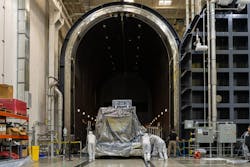Ball Aerospace and NASA complete new space telescope camera system
BROOMFIELD, Colo., - Ball Aerospace in Broomfield, Colorado, and its partners at the National Aeronautics and Space Administration's (NASA's) Goddard Space Flight Center in Greenbelt, Maryland, announced that they have successfully completed assembly of the Nancy Grace Roman Space Telescope's camera system, called the Wide Field Instrument (WFI). The WFI will serve as the observatory's primary instrument, providing the scientific community with detailed and expansive images of the cosmos.
The instrument will capture images at the same resolution as Roman's predecessor, the Hubble Space Telescope, but with a field of view at least 100 times greater. This scale of image collection will advance astronomers' access to new data considerably, promising the discovery of new planets outside of our solar system, a better understanding of the evolution of our universe and novel insights into mysterious phenomena like dark matter and dark energy.
"The completion of the Wide Field Instrument's integration is something that Ball Aerospace, NASA and the entire Roman team have been looking forward to for years," said Dr. Alberto Conti, vice president and general manager, Civil Space, Ball Aerospace. "Tools like the WFI will push the boundaries of space exploration and help us fill longstanding gaps in our understanding of the universe around us."
NASA's team at Goddard Space Flight Center ibuilt the WFI's focal plane system (FPS), relative calibration system, and the instrument command and data handling electronics. Ball Aerospace designed and built the WFI's opto-mechanical assembly, which includes the optical bench, element wheel, thermal control system, alignment compensation mechanism and more.
Ball Aerospace completed the integration of the FPS into the WFI in June and final WFI integration at the end of August.
Ball Aerospace will also lead environmental testing for the WFI. The monthslong effort will ensure the instrument can stand up to the extreme conditions of a rocket launch and function properly in the vacuum of space. Once testing is complete, Ball Aerospace will ship the WFI to Goddard Space Flight Center.
The Roman Space Telescope is expected to launch no later than May 2027.
